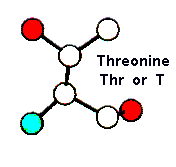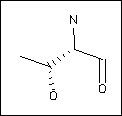

For an updated version of these pages, click here


Substitution preferences:
All protein types:
| Favoured | Ser ( 1) | |||||||
| Neutral | Ala ( 0) | Asn ( 0) | Val ( 0) | |||||
| Disfavoured | Asp (-1) | Glu (-1) | Ile (-1) | Lys (-1) | Met (-1) | Leu (-1) | Pro (-1) | Gln (-1) |
| Arg (-1) | Cys (-1) | Phe (-2) | His (-2) | Trp (-2) | Tyr (-2) | Gly (-2) |
| Favoured | ||||||||
| Neutral | Cys ( 0) | Asp ( 0) | Glu ( 0) | Lys ( 0) | Met ( 0) | His ( 0) | Ile ( 0) | Asn ( 0) |
| Pro ( 0) | Gln ( 0) | Arg ( 0) | Ser ( 0) | Ala ( 0) | Val ( 0) | |||
| Disfavoured | Leu (-1) | Phe (-1) | Tyr (-1) | Gly (-1) | Trp (-2) |
| Favoured | Ser ( 1) | |||||||
| Neutral | Ala ( 0) | Val ( 0) | Asp ( 0) | Glu ( 0) | Gly ( 0) | His ( 0) | Ile ( 0) | Lys ( 0) |
| Met ( 0) | Leu ( 0) | Asn ( 0) | Pro ( 0) | Gln ( 0) | Arg ( 0) | |||
| Disfavoured | Trp (-1) | Phe (-1) | Tyr (-1) | Cys (-5) |
| Favoured | Ser ( 2) | Asn ( 1) | Ala ( 1) | |||||
| Neutral | Gly ( 0) | Ile ( 0) | Met ( 0) | Cys ( 0) | Asp ( 0) | Val ( 0) | ||
| Disfavoured | Pro (-1) | Glu (-1) | Arg (-1) | Leu (-1) | His (-2) | Phe (-2) | Lys (-2) | Gln (-2) |
| Tyr (-3) | Trp (-4) |
Role in structure: Being a fairly indifferent amino acid, Threonine can reside both within the interior of a protein, or on the protein surface.
Threonine has an additional property that is frequently overlooked. Like Valine, and Isoleucine it is C-beta branched. Whereas most amino acids contain only one non-hydrogen substituent attached to their C-beta carbon, these three amino acids contain two. This means that there is a lot more bulkiness near to the protein backbone, and thus means that these amino acids are more restricted in the conformations the main-chain can adopt. Perhaps the most pronounced effect of this is that it is more difficult for these amino acids to adopt an alpha-helical conformation, though it is easy and even preferred for them to lie within beta-sheets.
Role in function: Threonines are quite common in protein functional centres. The hydroxyl group is fairly reactive, being able to form hydrogen bonds with a variety of polar substrates.
A common role for Threonines (and Serines and Tyrosines) within intracellular proteins is phosphorylation. Protein kinases frequently attach phosphates to Threonines in order to fascilitate the signal transduction process.
Note that in this context, Threonine can often be replaced by Serine, but is unlikely to be replaced by Tyrosine, as the enzymes that catalyse the reactions (i.e. the protein kinases) are highly specific (i.e. Tyrosine kinases generally do not work on Serines/Threonines and vice versa).